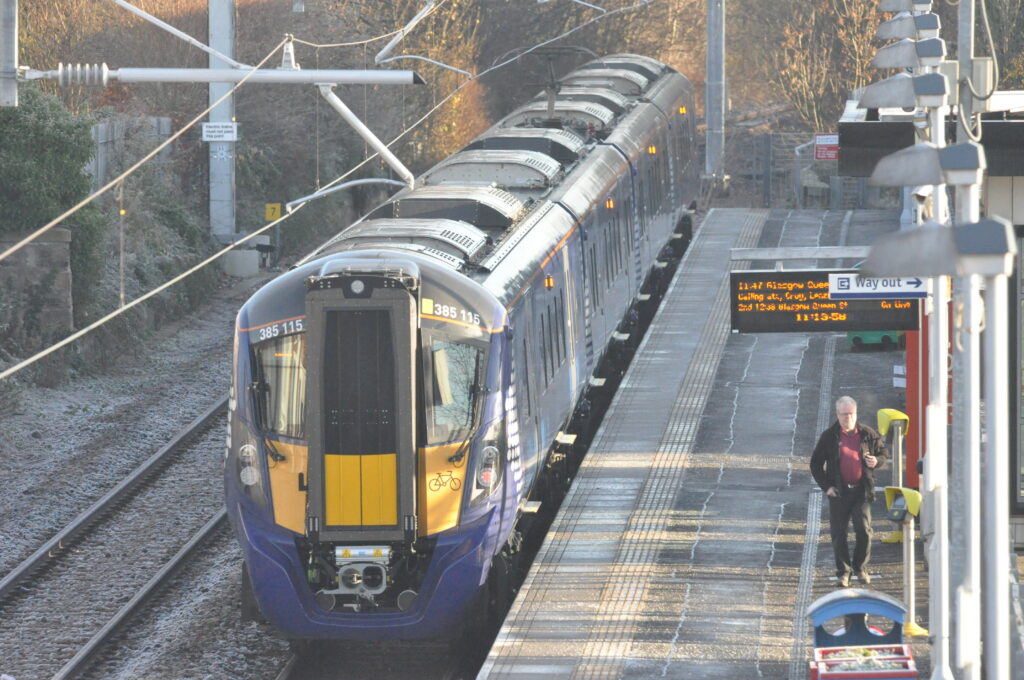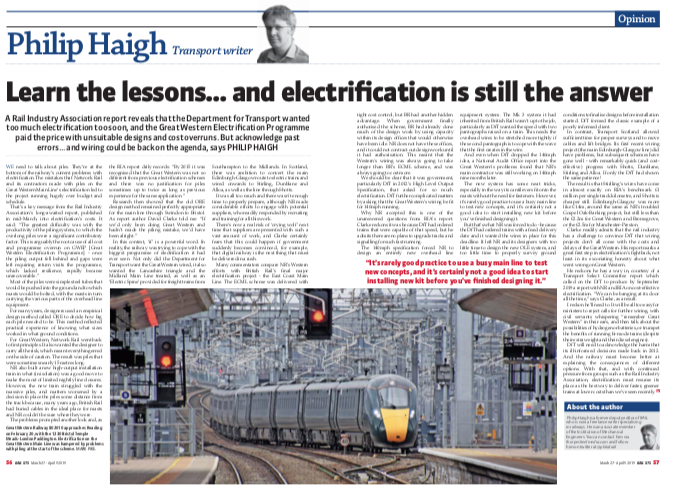We need to talk about piles. They’re at the bottom of the railway’s current problems with electrification.
The mistakes that Network Rail and its contractors made with piles on the Great Western Main Line’s electrification led to the project running hugely over budget and schedule.
That’s a key message from the Rail Industry Association’s long-awaited report into electrification’s costs, which it published in mid-March. It said: “The greatest difficulty was with the productivity of the piling system to which the overlong piles were a significant contributory factor. This is arguably the root cause of all cost and programme overrun on Great Western, once the piling output fell behind and gaps were left requiring return visits the programme, which lacked resilience, rapidly became unrecoverable.”
Most of the piles were simple steel tubes that pushed into the ground. Erectors then bolt masts to them and attach to the masts the various parts of the overhead line equipment. For many years, designers used an empirical design method called ORE to decide the size of each pile. This method reflected practical experience.
The cost of first principles
For Great Western, Network Rail went back to first principles. It also wanted the designer to carry all the risk which meant everything erred on the side of caution. The result was piles that were sometimes nearly 15-metres long.
NR built a new high-output installation train in what, in isolation, was a good move to make the most of limited nightly line closures. However, the new train struggled with those massive piles. Matters became worse with a decision to place the piles further from the track because, many years ago, British Raid buried cables in the ideal place for masts and NR couldn’t be sure where they were.
The problems prompted another look. RIA’s report drily records: “By 2015 it was recognised that the Great Western was not so different from previous electrification schemes and there was no justification for piles sometimes up to twice as long as previous experience for the same application.”
Research then showed that the old ORE design method remained perfectly appropriate for the main line through Swindon to Bristol. As report author David Clarke told me: “If we’d only been doing Great Western and hadn’t made the piling mistake, we’d have been alright.”
Too much electrification too soon
In this context, ‘if’ is a powerful word. In reality, the railway was trying to cope with the biggest programme of electrification it had ever seen. Not only did the Department for Transport want the Great Western wired, it wanted the Lancashire triangle and the Midland Main Line treated and an ‘Electric Spine’ provided for freight trains from Southampton to the Midlands. In Scotland, there was ambition to convert the main Edinburgh-Glasgow route to electric trains and wire onwards to Stirling, Dunblane and Alloa as well as the line through Shotts.
It was all too much and NR didn’t have enough time to properly prepare although it made considerable efforts to engage with potential suppliers who readily responded by recruiting and training. There’s now a real risk that suppliers will ‘cry wolf’ next time they see such a vast amount of work. Clarke certainly fears that this could happen if government suddenly decides, for example, that digital railway is the next thing the railway must deliver in a rush.
Many commentators compare NR’s Western efforts with British Rail’s final major electrification project, the East Coast Main Line. The ECML scheme was delivered with tight cost control but BR had another hidden advantage. When government finally authorised the scheme, BR had already done much of the design work by using capacity within its design offices that would otherwise have been idle. NR does not have these offices and it could not contract out design work until it received authorisation. This meant that the Western’s wiring was always going to take longer than BR’s ECML scheme and always going to cost more.
Asking for electrification
We should be clear that it was government, particularly DfT in 2012’s High Level Output Specification, that asked for so much electrification. DfT further complicated matters by asking that the Great Western’s wiring be fit for 140mph running. Why NR accepted this is one of the unanswered questions from RIA’s report. Clarke reckons it was because DfT had ordered trains that were capable of that speed. However, he admits there are no plans plans to upgrade tracks and signalling for such fast running.
The 140mph specification forced NR to design an entirely new overhead line equipment system. British Rail’s Mk 3 system wasn’t up to the job. This was because DfT wanted the speed with two pantographs raised on a train. This needs the overhead wires to be stretched more tightly if the second pantograph is to cope with the wave the first creates in the wire. Even when DfT dropped the 140mph idea, a National Audit Office report found that NR’s main contractor was still working on 140mph nine months later.
The new system has some neat tricks, especially in the way its cantilevers fit onto the masts without the need for fasteners. However, it’s rarely good practice to use a busy main line to test new concepts and it’s certainly not a good idea to start installing new kit before you’ve finished designing it.
Folly to install before design
That’s what DfT forced NR to do because the DfT had ordered trains with a fixed delivery date and it wanted the wires in place for this deadline. It left NR and its designers with too little time to design the new OLE system. It left too little time to properly survey ground conditions to finalise designs before installation started. DfT was the classic example of a poorly informed client.
In contrast, Transport Scotland allowed enough time for proper surveys and to move cables and lift bridges. Its first recent wiring project, the main Edinburgh-Glasgow line did have problems but subsequent schemes have gone well, with remarkably quick – and cost effective – progress with Shotts, Dunblane, Stirling and Alloa. If only the DfT had shown the same patience!

The result is that Stirling’s wires have cost almost exactly RIA’s benchmark £1 million per single track kilometre. Shotts was cheaper still. Edinburgh-Glasgow cost more like £1.4m, around the same as NR’s troubled Gospel Oak-Barking project. This was still less than the £2.2m for Great Western and Bromsgrove or the £2.5m for Manchester-Preston.
Difficult to convince DfT
Clarke readily admits that the rail industry has a challenge to convince DfT that wiring projects don’t all come with Great Western’s costs and delays. His report marks a great first step in electrification’s fightback, not least in its honesty about Great Western’s problems.
He reckons he has a way in courtesy of a Transport Select Committee report which called on the DfT to produce by September 2019 a report with NR and RIA on cost effective electrification. “We can be banging at its door all the time,” says Clarke as a result.
I reckon he’ll need to. It will be all too easy for ministers to reject calls for further wiring, with civil servants whispering “remember Great Western” in their ears. Then they’ll talk about hydrogen or batteries or trumpet the benefits of running bi-mode trains (despite their extra weight and their diesel engines).
DfT will need to acknowledge the harm its ill-informed decisions made back in 2012. The railway better explain the consequences of different options. With that, and with continued pressure from groups such as the Rail Industry Association, electrification must resume its place as the best way to deliver faster, greener trains at lower costs than we’ve seen recently.
The article first appeared in RAIL 875, published on March 27 2019.
